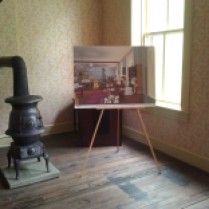I finally managed to visit a new historic site in Washington D.C, one I’ve walked by hundreds of times. It only became “official” in July 2015 when it opened to the public. But the narrow brick rowhouse has been standing at 437 Seventh St. for over 150 years, just blocks from Verizon Center where the Wizards and Capitals play. And, a few minutes walk from the original Patent Office (today the National Portrait Gallery).
Clara Barton is best known as the  founder of the American Red Cross. But much of her humanitarian work began in this house. Even before she was the “angel of the battlefield,” she was a trailblazer as one of the first, though often cited as the first, female clerks in the federal government. She moved to Washington in the mid-1850s to be a clerk at the U.S. Patent Office, but the position soon was downgraded and then eliminated because of opposition to her gender and politics. With the new Lincoln administration in 1861, she again took a job at the Patent Office. She rented two rooms at the site on 7th Street at some point during the Civil War. By August 1862 her focus had changed and she received permission to access the front lines and to distribute medical supplies. While not a trained nurse, she excelled at organization. She stockpiled supplies in her rooms and she eventually was granted more authority on behalf of the US Army to oversee medical care and provisions.
founder of the American Red Cross. But much of her humanitarian work began in this house. Even before she was the “angel of the battlefield,” she was a trailblazer as one of the first, though often cited as the first, female clerks in the federal government. She moved to Washington in the mid-1850s to be a clerk at the U.S. Patent Office, but the position soon was downgraded and then eliminated because of opposition to her gender and politics. With the new Lincoln administration in 1861, she again took a job at the Patent Office. She rented two rooms at the site on 7th Street at some point during the Civil War. By August 1862 her focus had changed and she received permission to access the front lines and to distribute medical supplies. While not a trained nurse, she excelled at organization. She stockpiled supplies in her rooms and she eventually was granted more authority on behalf of the US Army to oversee medical care and provisions.
The sign in the window of 437 does not say “Clara Barton slept here,” it says “Missing Soldiers Office.” From rooms on the 3rd floor, Barton and her staff of ten provided a ray of hope to thousands of families desperate to find loved ones after the end of the Civil War. People had already started contacting her during the war because they knew she had proximity to the soldiers. Recognizing the great need to help bring families together, she sought and eventually received authorization from the government to run this effort. She also eventually received $15,000 compensation for her four-year effort. From 1865-1868 her staff attempted to ease communication and find and identify soldiers killed and missing in action. The office received over 63,000 letters and managed to respond to over 40,000. They found and identified over 20,000 missing soldiers.
Hidden for over 130 years, the office and her quarters are in a building owned by the American government (GSA). Once a shoe store on the first floor, much of the building had not  been modernized and its most famous use had been forgotten. No one knew that objects left by Barton lay in the attic. A hand-painted tin sign advertising the office was an obvious clue. In 1996 a GSA carpenter entered the derelict building that was slated for demolition. An envelope caught his attention and curiosity led him to a treasure trove of primary source materials with stories to tell, over 350 boxes of artifacts.
been modernized and its most famous use had been forgotten. No one knew that objects left by Barton lay in the attic. A hand-painted tin sign advertising the office was an obvious clue. In 1996 a GSA carpenter entered the derelict building that was slated for demolition. An envelope caught his attention and curiosity led him to a treasure trove of primary source materials with stories to tell, over 350 boxes of artifacts.
Since the Government Services Administration in not in the business of running museums, they needed to figure out what to do. Eventually they found a partner in the National Museum of Civil War Medicine, based in Frederick, MD. Today, the museum runs the site and houses the artifacts.
While a visitor area on the first floor and a number of rooms on the third floor have been restored to their 1860’s appearance, a challenge remains. The office’s furniture had long since disappeared, so the rooms are sparsely furnished. Do visitors expect a furnished space? How can visitor imaginations be sparked? What is the main message and why is this office relevant today? The museum staff must ultimately figure out who their audiences are and how to engage future visitors. The place’s power to transport visitors back to wartime Washington is undeniable and the building has an important story to tell of this unique time in the city’s history.
Learn more about how the building’s secret was discovered.
Also in the neighborhood:
Lincoln history and Chinese food








